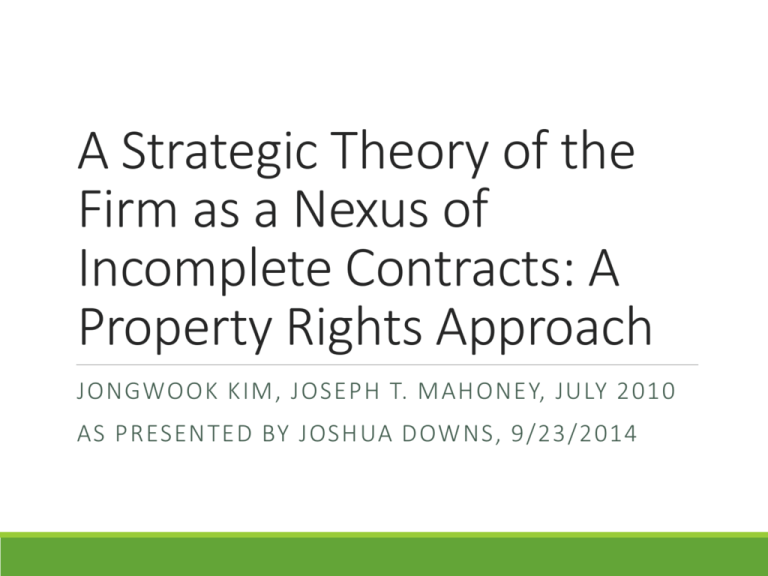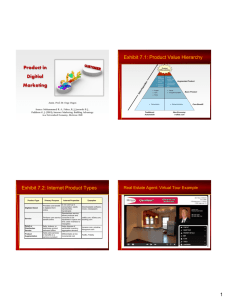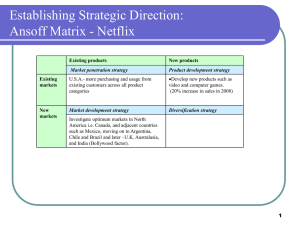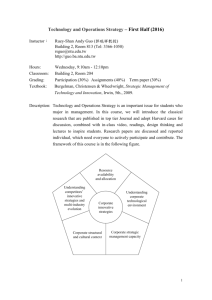Slides
advertisement

A Strategic Theory of the Firm as a Nexus of Incomplete Contracts: A Property Rights Approach JONGWOOK KIM, JOSEPH T. MAHONEY, JULY 2010 AS PRESENTED BY JOSHUA DOWNS, 9/23/2014 Overview Discussion of nascent and under-defined field of Dynamic Capabilities using a blend of Property Rights and Austrian Economics Compares and contrasts this approach with aspects of transaction costs & resource theory Defines the firm as a Nexus of Incomplete Contracts that represent an allocation of alienable property rights which can be strategically realigned with inalienable resources as contractual learning takes place to generate and capture new economic value Resources as Bundles of Property Rights Resources can be partitioned into aspects of ownership: transfer, collection of rents, etc. Economic Transactions are exchanges of bundles of partitioned property rights to resources Decision makers are expected to maximize economic efficiency through partitioning and transacting property rights, and the contracting process contributes to learning for these decision makers The organizational processes of maximizing economic efficiency (integration or coordination, learning, and reconfiguration or transformation) can be defined as dynamic capabilities These processes can also be defined in terms of property rights theory… Internalizing Externalities: Establishing Economic Value Dynamic Capabilities are how firms internalize externalities so that decision makers capture the full extent of economic benefits and incur the full extent of their economic costs Resources and Capabilities can be unbundled and reconfigured internally & in the marketplace The repetitiveness of these organizational processes allows decision makers to improve efficiency and identify new opportunities Firm Boundaries Transaction costs define the firm through economizing make-or-buy decisions Austrian view (Penrose) states that Firm performance can differ in turbulence Therefore, firm boundaries are more defined by knowledge, foresight and co-specialization of human capital to physical assets that allow firms to expand by fully utilizing resources that are tied to the firm Entrepreneurs tie resources to the firm through a series of incomplete contracts Generating Economic Rents Transaction Costs rents come from economizing on costs of transacting across firm boundaries and capturing quasi-rents Countering, Penrose states rents are derived from the superiority of certain managers to recognize and capture from the “Subjective Opportunity Set”, therefore, rents are derived from entrepreneurial alertness and innovative capacity Property rights theory brings contractual approach to entrepreneurial discovery ◦ The search for entrepreneurial rents is a discovery process which uncovers opportunities previously hidden due to market incompleteness ◦ The establishment of new property rights through shifts in technology or price is consistent with entrepreneurial approach of Austrian Economics Systemic View Entrepreneurial capacity difficult to measure ex ante, but firm processes provide context Routines and patterned activities can contextualize capability development, capabilities can be sustained through subsequent institutional normalization, while adaptability for rejuvenation is maintained through flexible informal practices and inherent nature of incomplete contracts Property rights systems become conduits for value-creating activities where resources are channeled to higher yield uses Processes for establishment of property rights (contracting) are where information is derived that can reduce instances for opportunism and thus create value by improving likelihood of resource allocation to increasingly higher yield use Nexus of Incomplete Contracts Firms are viewed as coalitions of resource holders and firm’s goal is to maximize economic output of resources through coordination with capabilities through contractual relationships (internal & external) Contracts are incomplete due to resources and capabilities that are difficult to contract on like tacit know-how, and co-specialization The existence of residual property rights control indicates an incomplete contract ◦ This can be indicative of exchange hazards ◦ However, can represent opportunities for gain to the extent that the contract is incomplete The nexus implies that the firm has many different providers of resources and capabilities contributing to value creation, but with differing extents of commitments Descriptive Tables Conclusions Because resources are scarce and property rights can be bundled and unbundled, entrepreneurial insight can be superior to a pure market mechanism in creating and sustaining competitive advantage. The contractual process is an avenue through which firms can discover new opportunities to maximize economic value ◦ Examples can include improving efficiencies within inter-firm transactions Through the development of entrepreneurial insight sparked by this learning, new market opportunities can be identified ◦ By bundling and rebundling property rights, resources can be aligned to capture these opportunities in ways that create competitive advantage ◦ Firms normalize certain processes while leaving flexibility in others to create sustainability, contractual learning helps entrepreneurs in these decisions. Example 1: Netflix Streaming Utilization of Postal Service ◦ Negotiated deal reduces automation rate,¹Free by-hand sorting² Utilization of ISPs ◦ Previous experience grants opportunity recognition and capture ◦ Largest traffic provider ◦ Purchasing channels from Cogent³ ◦ Comcast changed policy with Cogent ◦ Netflix traffic became congested ◦ Netflix negotiated directly with Comcast ◦ Since agreeing to pay Comcast, Netflix also has agreed to pay TWC, AT&T and Verizon for interconnection. ◦ Testified to block Comcast/TWC Merger Example 2: Netflix Streaming Content Netflix-by-mail negotiates discount rates for bulk purchases Netflix Streaming requires licensed content ◦ ◦ ◦ ◦ ◦ ◦ 2008: Contracts with Starz for content (approx. $30M)¹ Streaming boom for Netflix, Starz competitor Disney expresses displeasure with Starz 2010: Netflix agrees to $200M annual license with studios for content² 2011: Netflix ends negotiations with Starz for $200M³ 2012: Netflix agrees to deal with Disney⁴ Netflix gradually acquiring individual series according to consumer demand ◦ 2014: Netflix agrees to $2M per episode for Blacklist⁵ Discussion How can the competitive advantage derived from managerial entrepreneurial insight be maintained given the inevitability of entrepreneurial ambition? Entrepreneurial board? Entrepreneurial shareholders? If a manager’s capacity to learn to recognize and capture opportunities is paramount, then is hiring them after gaming the media bad if they can be properly incentivized?





